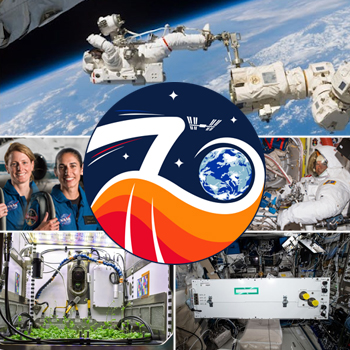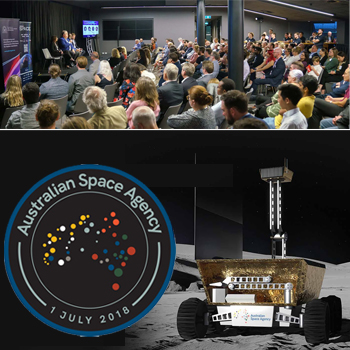ISS Expedition 70 Focuses on EVAs, Cargo Operations, Coolant Leak Investigation
The newly commenced Expedition 70 mission at ISS is planning for next EVAs starting October 25 with Russia EVA #61 to mount a synthetic radar communications system, deploy a solar sail satellite, and replace electrical connector patch panels. The coolant leak detected from a backup radiator in Nauka Multipurpose Laboratory Module is being assessed and appears to have had no negative impact on the crew or station. It has changed the schedule for 2 USA EVAs that were postponed from Oct 12 and 20, one of which would see NASA Astronauts Loral O’Hara and Jasmin Moghbeli exit the station for U.S. spacewalk #90. It will mark the second-ever all women EVA; the first occurred October 2019 with Expedition 61 Flight Engineers Christina Koch and Jessica Meir. As commented by NASA Astronaut Tracy Caldwell Dyson, “…not to overshadow women [who] have been doing spacewalks for 35 years. I think many of us are looking forward to this just being normal”. O’Hara, Meir and the 5 other Exp 70 members Oleg Kononenko, Nikolai Chub, Konstantin Borisov, Satoshi Furukawa and Andreas Mogensen will continue experiments for ocular and heart health, cancer treatments, 3D manufacturing, Cold Atom Lab, and combustion investigations. The crew is also transferring cargo from the currently docked Progress 84P & 85P and Cygnus NG-19 S.S. Laurel Clark. Before the end 2023, Exp 70 will help facilitate Progress 84P reentering Earth atmosphere and the arrival of 2 additional cargo ships. (Image Credits: NASA, ISS Partners, HP Enterprise)
|
MONDAY☆ Oct 16 — International Space Station, ~415-km LEO: Expedition 70 seven-member crew rearranging planned EVAs due to coolant leak investigation, participating in in-flight events with NASA, Fox, Yahoo, and Ascend Conference. ☆ Oct 16 — Tiangong Space Station, ~390-km LEO: Shenzhou 16 preparing for return to Earth early next month after Shenzhou 17 three-member crew arrives in late Oct. Highlights… o NewSpace: PLD Space of Spain working to achieve reusability following successful suborbital launch of Miura-1; Astrobotic to conduct testing campaigns with VTVL Xodiac platform for NASA and Draper following return to flight; Stoked Space to advance full-reusable Nova launch vehicle with US$100M fundraising round. ☆ Solar System: Astronauts including Jessica Meir training for lunar missions at JSC Rock Yard while next JETT analog in Flagstaff AZ pushed to 2024; 40-m radio telescopes being built in Shigatse and Changbai Mountains to advance China VLBI network for astronomy / deep space mission support; New Horizons dust counter readings suggest existence of ~12 objects in 2nd Kuiper belt past 60 AU. ☆ Galaxy: Magnetic Fusion Plasma Drive may provide novel propulsion necessary for interstellar travel per Leiden Univ. Professor Florian Neukart; Understanding of extremely young star cluster IRS13 formation near SMBH Sagittarius A* aided by JWST observation; Dark matter / energy surveyor Euclid resuming performance verification commissioning phase following software patch for star tracker fault. o Global: KARI negotiating with Roscosmos for Arirang 6 and Compact Advanced Satellite 500-2 launch contract termination; Construction of commercial spaceport in Tamil Nadu designed for SSLV expected to be complete in 2 years; National Astronomical Research Institute of Thailand (NARIT) to participate in China-led International Lunar Research Station. ● USA: 200+ scientists to spend 2 years studying Bennu samples as preliminary analysis finds carbon and water; Quad Cities International Airport pursuing horizontal launch capability with $283,000 feasibility study; National Reconnaissance Office to increase orbital fleet 4x, resulting in 10x imaging / signal detection coverage. ● Hawai’i: Gemini North on Mauna Kea resumes operations after cybersecurity issues while Gemini South in Chile is shut down for maintenance until Nov; PISCES begins Space Science Symposium talk series with HIGP and HSFL discussion. |
 |
● = Terrestrial and… o = International terrestrial events
☾ = Moon activity ★ = Space and… ☆ = International space / astro events in Hawaii Standard Time unless noted. Add 10 hours to obtain UT (‘Universal Time’). |
Weekly Planet Watch – Evening Planets: Jupiter (ENE), Saturn (SE), Uranus (E), Neptune (SE). Morning Planets: Venus (E).
Australia Hosts Domestic and International Space Conferences, Conducting Moon Rover Naming Contest
Space Industry Association of Australia (SIAA) is hosting Southern Space 2023 at Hotel Realm in Canberra October 17-18, bringing Australian space industry together with government policymakers to advance domestic space capabilities. Despite the cancellation of the $1.2B National Space Mission for Earth Observation (NSMEO) planned by the prior federal government, Australian Space Agency continues to receive $34.2M in core funding with which to advance key priorities including space programs / initiatives, supporting NASA-led Artemis missions, international space collaboration, and regulation of Australian space activities. Tickets for the 2-day event for are available for AUD$925 (free for SIAA members). Australian Space Agency is accepting submissions to name its lunar rover, which is set to ride to the Moon on a NET 2026 NASA Artemis mission, until October 20. Entries will be judged on relevancy, creativity and rationale. 4 names will be shortlisted and the Australia population will vote on a winner, to be announced on December 6. The rover will collect regolith for a technology demonstration of oxygen extraction. Leaders in diverse industries including space, robotics, mining, agriculture and AI from Australia, India, USA, Japan, Ethiopia, Switzerland, Malaysia, Singapore, Israel, Egypt, Scotland and The Netherlands are gathering October 23-24 at Pan Pacific Hotel in Perth for the Indo-Pacific Space and Earth Conference. In 2025, the 76th International Astronautical Congress will be held at the International Convention Centre in Sydney. (Image Credits: SIAA, ASA) |
★ Oct 16 — Lucy, Inner Main Asteroid Belt: NASA spacecraft to encounter 11 asteroids reaches 2nd full year / enters 3rd in space since launching this day via ULA Atlas V in 2021. ● Oct 16 — NASA Ames Research Center, Mountain View CA and Online: NASA Ames Hosts Briefing on New interdisciplinary Initiative; with remarks from Ames Director Eugene Tu, U.S. Congresswomen Anna Eshoo and Zoe Lofgren, 10:00 PDT. o Oct 16-18 — ASTROMEET Committee, Bulgarian Academy of Sciences, Albedo Meetings, et al, Dubai, United Arab Emirates: 2nd International Meet on Astronomy and Astrophysics (ASTROMEET2023). ☆ Oct 16 — Apollo Asteroid 2023 TA4: Near-Earth Flyby (0.018 AU). ☆ Oct 16 — Apollo Asteroid 2019 UZ3: Near-Earth Flyby (0.024 AU). Ongoing… ☾ Sep 6 – NET Jan/March — Smart Lander for Investigating Moon (SLIM), Lunar Landing Trajectory: SLIM Moon mission 4-6 month trajectory to soft land east of Shioli crater (13.2°S, 25.2°E) on Moon near side equatorial region. ☆ Sep 6 – NET Mar — X-Ray Imaging and Spectroscopy Mission (XRISM), ~550-km LEO: XRISM undergoing 6 month check out testing phase before start of science operations to study galactic plasma. ★ NET Q4 — ULA, Launch Vulcan Centaur / Astrobotic Peregrine Lander, SLC-41, Cape Canaveral SFS FL: Astrobotic Peregrine lander to attempt to touchdown near Gruithuisen Domes, with 14 NASA payloads for Artemis Program, CMU Iris Lunar Rover, total 90 kgs of customer payloads from commercial companies and international space agencies, institutions. TUESDAY☆ Oct 17 — INTErnational Gamma-Ray Astrophysics Laboratory (INTEGRAL), LEO: Detecting some of the most energetic radiation in Space, ESA, NASA, RSA spacecraft reaches 21 full years / enters 22nd of operations in space; launched 2002, science operations extended to end of 2024, expected to run out of fuel mid 2020s and fall to Earth Feb 2029. ● Oct 17-18 — SatNews, Mountain View CA: Satellite Innovation; during Silicon Valley Space Week, at Computer History Museum. o Oct 17-18 — Space Industry Association of Australia (SIAA), Canberra, Australia: Southern Space 2023. ● Oct 17-19 — National Academies of Sciences, Engineering, and Medicine, Washington DC: 172nd Meeting of the Aeronautics and Space Engineering Board (ASEB). |
o Oct 17-19 — Western University, Institute for Earth & Space Exploration, Ottawa, Ontario, Canada: Spacebound Conference 2023.
☆ Oct 17 — Apollo Asteroid 1998 HH49: Near-Earth Flyby (0.007 AU).
WEDNESDAY
● Oct 18 — Astronaut Scholarship Foundation, Online / Orlando FL: Live Chat Series: NASA Astronaut Charlie Bolden; for middle and high school students, 14:15 EDT.
☾ Oct 18 — Moon: 0.83° NNE of Antares, 05:00.
☆ Oct 18 — Mercury: 2.99° NNE of Spica, 13:00.
THURSDAY
★ Oct 19 — Interstellar Boundary Explorer (IBEX), HEO: NASA spacecraft mapping boundary between the Solar System and interstellar space reaches 15 full years / enters 16th year in Space today, launched on this day 2008.
☆ Oct 19 — ExoMars 2016 Orbiter, Mars Orbit: ESA and Roscosmos spacecraft reaches 7 full years / enters 8th years at Mars, launched 2016; craft continues collecting data on atmosphere, deployed Schiaparelli demonstration lander 19 Oct 2016 (unsuccessful).
☆ Oct 19 — Mercury: At superior conjunction with Sun, 1.421 AU from Earth, 19:00.
☆ Oct 19 — Apollo Asteroid 2022 UO10: Near-Earth Flyby (0.019 AU).
FRIDAY
☆ Oct 20 — BepiColombo, Mercury Trajectory: European Space Agency / JAXA Mercury Planetary Orbiter (MPO) and Mercury Magnetospheric Orbiter (dubbed Mio ‘waterway or fairway’) reach 5 full years / enter 6th year in space today, launched 2018; expected to reach Mercury polar orbit 2025 to map planet, investigate magnetosphere.
● Oct 20 — Stanford on the Moon (SOM), Space Age Publishing Company, Stanford CA: SOM Symposium 2023: USA Returns to the Moon; during Stanford Alumni Reunion Conference, 15:00-17:00 in Varian Physics Building rooms 102-103; RSVP.
o Oct 20 — Australian Space Agency, Online: Opening of Competition to Name Australia’s Lunar Rover; open to Australian residents, ASA robotic rover will launch on future NASA Artemis Moon mission as early as 2026.
☆ Oct 20 — Apollo Asteroid 2020 UR: Near-Earth Flyby (0.014 AU).
SATURDAY
☆ Oct 21 — ISRO, Launch GSLV L40 / Gaganyaan Test Vehicle Demonstration 1, Satish Dhawan Space Center, Sriharikota, India: Gaganyaan uncrewed capsule to be launched to 11 km for high altitude abort test; capsule should reach 15-16 km testing separation from the rocket, trajectory and parachute deployment.
o Oct 21 — International Observe the Moon Night Organization, Global: International Observe the Moon Night 2023; encouraging observation, appreciation, understanding of the Moon and its connection to planetary science & exploration; 1st quarter Moon is considered the best time to observe the Moon due to shallow angle of sunlight hitting surface and illuminating details.
☾ Oct 21 — Moon: At first quarter, 17:29.
SUNDAY
☆ Oct 22 — Orionids Meteor Shower Peak: The 2nd of 2 showers from Halley’s Comet dust, Orionids appear to radiate from Constellation Orion, are swift (68 km/sec), can be bright & leave persistent trains; between 20-70 meteors per hour.
☆ Oct 22 — Venus: At dichotomy (50% phase), 12:00; Venus will resemble a small First Quarter Moon D-shape when viewed through a telescope.
☆ Oct 22 — Apollo Asteroid 2023 TX2: Near-Earth Flyby (0.033 AU).

